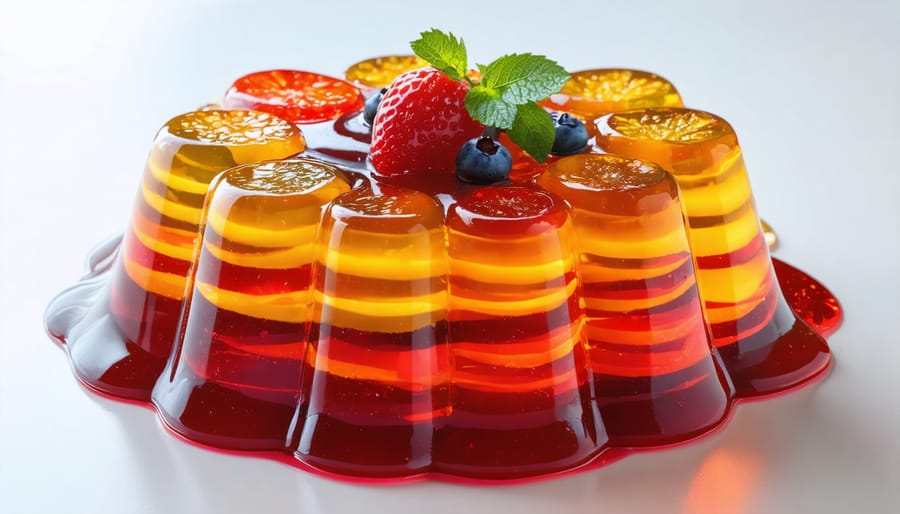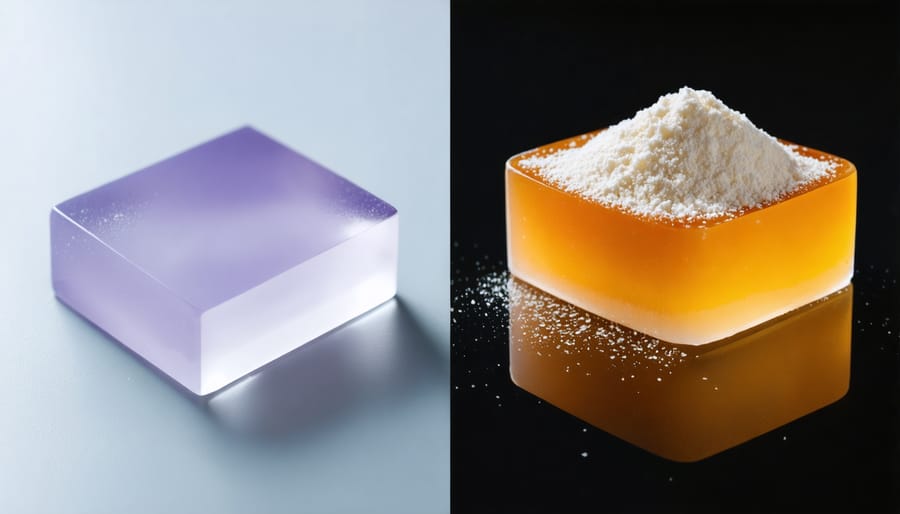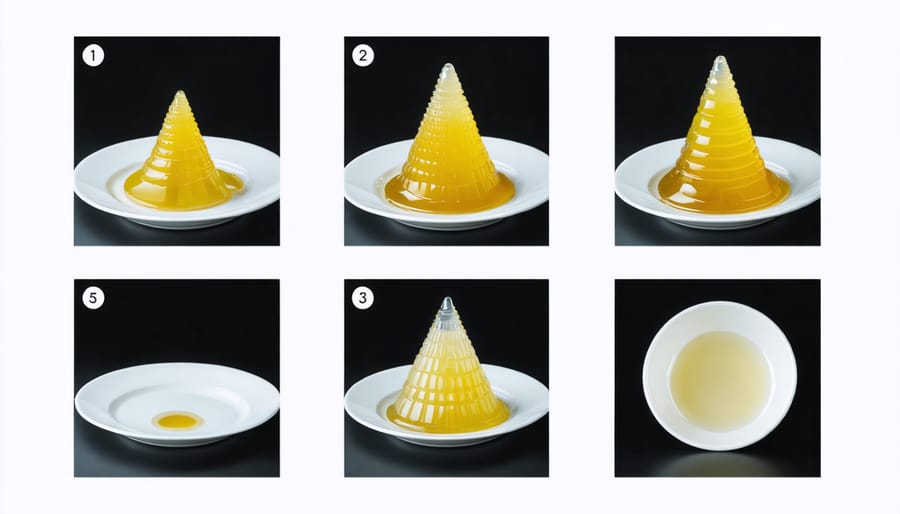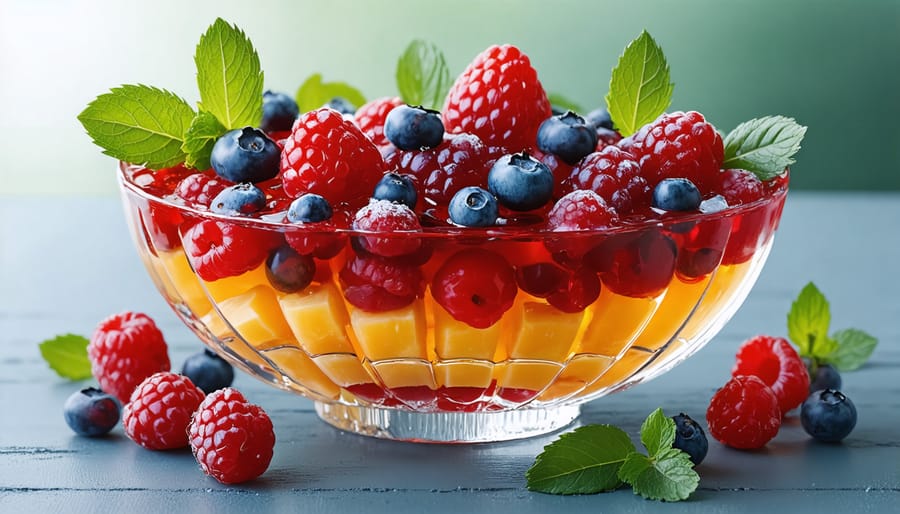
Transform your cooking with plant-based gelatin, the versatile alternative that’s revolutionizing desserts and savory dishes alike. Whether you’re embracing a plant-based lifestyle or simply exploring creative cooking options, agar-agar, carrageenan, and pectin offer incredible gelling power without animal products. These natural alternatives deliver the perfect wobble in your favorite jellies, mousses, and custards, while aligning with both paleo and vegan principles. Unlike traditional gelatin, plant-based options set more quickly at room temperature and maintain their structure even in warm conditions. Best of all, they’re packed with beneficial fiber and minerals, making them a nourishing addition to your culinary toolkit. Ready to dive into a world where compassionate cooking meets innovative texture? Let’s explore how these earth-friendly alternatives can elevate your favorite recipes.
Understanding Plant-Based Gelatin Alternatives
Agar Agar: The Sea Vegetable Star
Meet agar agar, the superstar of plant-based gelling agents! Derived from red seaweed, this versatile ingredient has been a staple in Asian cuisine for centuries before making its way into modern plant-based kitchens. What makes it truly special is its impressive gelling power – it’s actually stronger than traditional gelatin!
I discovered agar agar during my journey to create the perfect vegan panna cotta, and I’ve never looked back. Unlike animal-based gelatin, it sets firmly at room temperature and can withstand higher temperatures without melting, making it perfect for summer desserts. Plus, it’s virtually tasteless, allowing your other ingredients to shine through.
One of my favorite things about agar agar is its quick-setting nature. While traditional gelatin needs hours in the fridge, agar agar typically sets in about an hour. It does require a bit more attention during preparation – you’ll need to bring it to a boil to activate its gelling properties – but the results are worth it. The texture is slightly firmer than gelatin, creating clean-cut desserts that hold their shape beautifully.
Remember, a little goes a long way – you’ll typically need less agar agar than gelatin in recipes.

Carrageenan and Other Seaweed-Based Options
When I first discovered carrageenan in my plant-based cooking journey, it was like finding a magical ingredient from the sea! This red seaweed derivative has been used for centuries and offers a fantastic gelatin-like texture that works wonderfully in desserts and other dishes. It creates a firm, clear gel that holds up well at room temperature – perfect for those summer picnic treats!
Another star from the ocean is agar-agar, which comes from red algae. I love using it because it sets more firmly than traditional gelatin and doesn’t require refrigeration to maintain its shape. Just remember that it needs to be boiled to activate its gelling properties, unlike regular gelatin.
Beyond these popular options, there’s also Irish moss (or carrageen moss), which provides a softer set and works beautifully in mousses and puddings. For those who enjoy experimenting, dulse and other seaweed varieties can add subtle thickening properties to your dishes while bringing along beneficial minerals from the sea.
What I particularly appreciate about seaweed-based options is their versatility – they work in both sweet and savory applications, and a little goes a long way. Plus, they’re sustainable choices that connect us to traditional food practices from various coastal cultures.
Perfecting Your Plant-Based Gelling Technique
Temperature Matters
Getting the right temperature is key to achieving that perfect wobble in your plant-based gelatin creations. Just like when you perfect your cooking technique, understanding temperature control can make or break your recipe.
Here’s a little secret I learned after countless kitchen experiments: plant-based gelatin typically needs to be heated between 185°F and 195°F (85°C to 90°C) to activate properly. Too hot, and you might break down the gelling properties; too cool, and it won’t set properly. Think of it like making the perfect cup of tea – temperature precision matters!
For setting, most plant-based gelatins work best when chilled between 35°F and 40°F (2°C to 4°C). I keep a thermometer handy and always let my mixtures cool to about 120°F (49°C) before pouring them into molds. This prevents uneven setting and those pesky air bubbles we’ve all encountered.
Remember that different plant-based options have slightly different temperature sweet spots. Agar sets at a higher temperature than carrageenan, for instance, and remains stable even at room temperature. When in doubt, start with the package instructions and adjust based on your kitchen’s conditions and the specific recipe you’re creating.

Texture Tips and Troubleshooting
Getting the perfect texture with plant-based gelatin might take a little practice, but don’t worry – I’ve got your back! After countless experiments in my kitchen, I’ve discovered some foolproof solutions to common challenges.
If your mixture isn’t setting properly, the most likely culprit is temperature. Unlike traditional gelatin, plant-based alternatives need to be heated to the right temperature to activate properly. Keep a kitchen thermometer handy and aim for about 185°F (85°C) when dissolving your powder.
Finding your mixture too firm? Try reducing the amount of plant-based gelatin by ¼ teaspoon at a time. Too soft? Add a little more, but remember that most plant-based options take longer to set than traditional gelatin – patience is key! I usually give my desserts at least 4 hours in the fridge, though overnight is ideal.
Grainy texture can be frustrating, but it’s easily fixed by blending your mixture thoroughly before setting. I like to use an immersion blender for the smoothest results. If you notice any clumps forming while mixing, strain the liquid through a fine-mesh sieve before pouring it into your mold.
Remember that different brands may behave differently, so it’s worth experimenting to find your favorite. Keep notes on what works best for your specific recipes – I know I wished I had done this when I first started!
Paleo-Friendly Recipe Applications
Fruit-Based Desserts
Creating stunning fruit-based desserts doesn’t mean you have to compromise on your dietary choices. As someone who’s experimented extensively with healthier dessert alternatives, I’ve discovered that plant-based gelatin offers incredible versatility when working with fruits.
Start with a base of agar agar or carrageenan, combined with your favorite seasonal fruits. Summer berries work beautifully in jellied desserts, creating vibrant layers that catch the light perfectly. Try layering strawberry puree with coconut milk for an Instagram-worthy parfait, or create elegant berry-filled domes that will wow your dinner guests.
For a truly show-stopping presentation, try the crystal fruit technique: Use clear plant-based gelatin to encase thin slices of citrus fruits, creating a stunning stained-glass effect. This works particularly well with oranges, lemons, and blood oranges.
One of my favorite tricks is to combine pureed mango with coconut cream and plant-based gelatin for a tropical dessert that sets beautifully. The natural pectin in some fruits, like apples and citrus, can actually help enhance the setting properties of your plant-based gelatin.
Remember to always let your fruit purees cool slightly before adding them to your gelatin mixture to ensure proper setting. For added texture, try suspending fresh fruit pieces throughout your dessert – just make sure they’re completely dry to prevent any unwanted moisture from affecting the setting process.
These desserts aren’t just beautiful – they’re packed with natural sweetness and nutrients, making them perfect for anyone looking to indulge mindfully while maintaining their paleo lifestyle.

Savory Applications
Let’s dive into the exciting world of savory plant-based gelatin applications! While many of us think of gelatin as primarily for desserts, it’s actually a game-changer in savory paleo cooking. I discovered this myself when trying to recreate my grandmother’s famous aspic dish without traditional gelatin.
Plant-based gelatin alternatives like agar-agar and carrageenan work beautifully in savory dishes, creating stunning terrines, aspics, and molded salads that will impress even the most traditional food lovers. One of my favorite applications is using agar-agar to make a vibrant vegetable terrine – layers of colorful roasted vegetables held together in a clear, herb-infused broth that sets firmly when chilled.
For those new to savory applications, start with a simple bone broth alternative. Mix your favorite vegetable stock with agar-agar, add herbs and spices, and you’ll have a protein-rich, gut-friendly base for numerous dishes. The key is to remember that plant-based gelatin typically sets more firmly than traditional gelatin, so you’ll want to use slightly less than recipes might call for.
Some crowd-pleasing savory applications include:
– Mushroom pâté with fresh herbs
– Vegetable-packed aspic
– Savory “jello” shots with tomato and herbs
– Molded cauliflower rice dishes
– Clear consommés with suspended vegetables
Remember to experiment with different concentrations of your plant-based gelatin. Start with small test batches until you find the perfect consistency for your dish. The beauty of these alternatives is that they’re not only paleo-friendly but also bring their own unique nutritional benefits to your cooking.
As we’ve explored throughout this article, plant-based gelatin alternatives offer exciting possibilities for paleo cooking enthusiasts looking to expand their culinary horizons. Whether you choose agar-agar for its versatility, carrageenan for its unique texture, or pectin for your favorite fruit-based desserts, these natural alternatives can transform your paleo recipes into delicious masterpieces that everyone can enjoy.
I’ve personally found that experimenting with different plant-based gelatin options has opened up a whole new world of creative cooking in my kitchen. From perfectly set puddings to gorgeous jellied desserts, these alternatives have never let me down. The best part? They’re not just substitutes – they’re incredible ingredients in their own right.
Don’t be afraid to start small and gradually build your confidence with these plant-based options. Try a simple fruit jelly with agar-agar, or experiment with a coconut milk pudding using carrageenan. Remember, every kitchen adventure is an opportunity to learn and grow.
Ready to begin your plant-based gelatin journey? Your next amazing paleo creation awaits! Share your experiences and favorite recipes with our community – we’d love to hear how these alternatives work in your kitchen.



